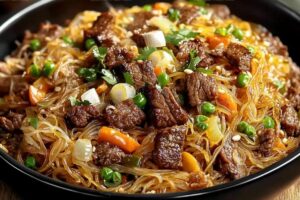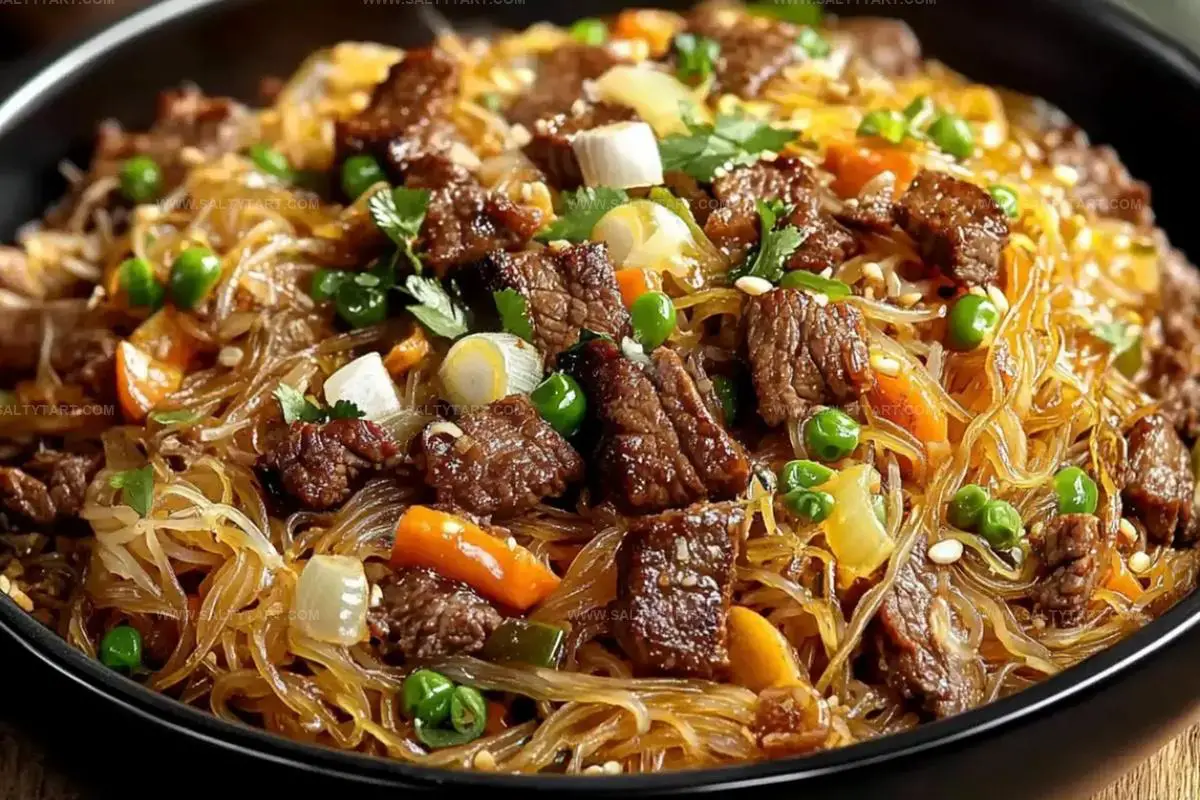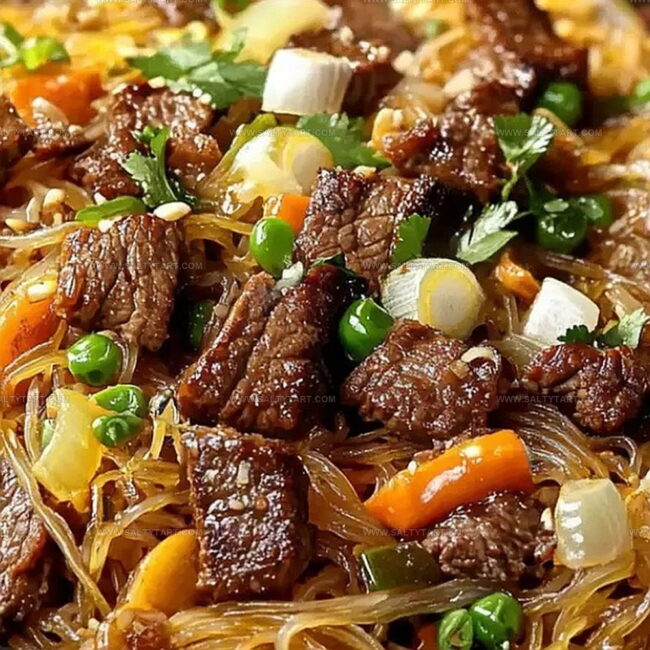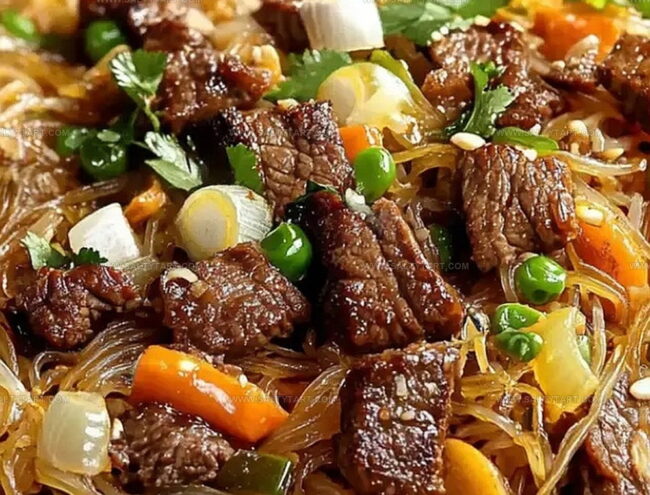Sizzling Filipino Pancit With Beef Recipe: A Flavorful Fiesta
Noodles dance with savory beef in this classic Filipino pancit that brings comfort and flavor to every bite.
The traditional dish weaves together tender strips of meat and silky strands of pasta.
Generations have cherished this hearty meal that connects families through its rich culinary heritage.
Each forkful tells a story of Filipino cooking traditions and warmth.
Colorful vegetables add brightness and crunch to the robust beef base.
The secret lies in balancing seasonings that create a symphony of taste.
Prepare to be transported by this delectable recipe that promises to satisfy your deepest hunger and culinary curiosity.
Why Filipino Pancit With Beef Is a Classic
Everything for Filipino Pancit With Beef Dinner
Main Ingredients:Vegetables:Seasonings and Oils:Steps to Make Filipino Pancit With Beef
Step 1: Soak Rice Noodles
Submerge the rice noodles in warm water according to the package instructions. Let them soften while preparing other ingredients.
Step 2: Prep Protein and Produce
Slice beef into thin, bite-sized strips. Chop vegetables into uniform pieces:Step 3: Sizzle Beef in Skillet
Heat canola oil in a large wok or wide skillet over medium-high heat.
Add beef, onions, and garlic. Splash in soy sauce and cook until beef develops a golden-brown crust.
Step 4: Build Flavor Base
Pour chicken stock into the skillet. Toss in:Simmer until vegetables become tender and slightly translucent.
Step 5: Marry Noodles and Mixture
Drain softened rice noodles and fold them into the beef and vegetable medley. Gently stir to ensure even distribution of ingredients.
Season with additional salt and pepper if desired.
Step 6: Present and Enjoy
Transfer the steaming pancit to serving plates.
Garnish with extra green onions. Serve immediately while hot and savor the delicious Filipino-inspired dish.
Notes for Traditional Pancit Beef Noodles
Fun Twists for Filipino Pancit Recipes
Pairings That Go Well With Beef Pancit
Storing Filipino Pancit for Later Meals
FAQs
Pancit is a popular Filipino noodle dish typically made with rice noodles, meat, and vegetables, representing a staple in Filipino cuisine that’s often served during celebrations and gatherings.
Pancit can be a complete meal as it contains protein from beef, carbohydrates from noodles, and various vegetables, providing a balanced and nutritious dish.
Rice noodles are traditional and work best, specifically bihon or canton noodles, which have the right texture and authentic Filipino flavor profile.
Yes, you can easily substitute beef with chicken, pork, shrimp, or make a vegetarian version using tofu or simply increasing the vegetable content.
Print
Filipino Pancit With Beef Recipe
- Total Time: 30 minutes
- Yield: 4 1x
Description
Savor the rich flavors of Filipino Pancit with Beef, a hearty noodle dish that blends tender meat and colorful vegetables. Perfectly balanced and comforting, you’ll enjoy this classic meal that brings the warmth of Philippine cuisine to your table.
Ingredients
Protein:
- 1 pound beef, sliced into bite-sized pieces
Noodles and Vegetables:
- 1 package (8.8 ounces/250 grams) Thai Vermicelli rice noodles
- 2 cups shredded cabbage
- 1/2 cup sliced carrots
- 1 yellow onion, diced
- 3 green onions, diced
- 6 cloves garlic, minced
Seasonings and Liquids:
- 2 tablespoons canola oil
- 2 tablespoons soy sauce
- 1 cup chicken stock
Instructions
- Submerge rice noodles in warm water, following package instructions to achieve optimal softness and texture.
- Expertly slice beef into uniform bite-sized pieces and precisely dice vegetables for even cooking.
- Ignite canola oil in a spacious wok or expansive saute pan, heating to medium-high temperature for ideal searing conditions.
- Introduce beef, fragrant yellow onion, aromatic minced garlic, and savory soy sauce into the heated pan. Sizzle for 3-5 minutes until beef develops a rich, golden-brown exterior. Enhance with judicious salt and pepper seasoning.
- Cascade chicken stock into the pan, then layer in crisp shredded cabbage, vibrant sliced carrots, and fresh diced green onions. Simmer 3-5 minutes until vegetables reach tender perfection.
- Drain soaked noodles and fold them into the robust beef and vegetable medley. Gently toss to ensure comprehensive integration of flavors and ingredients.
- Perform final taste assessment, adjusting seasoning with additional salt and pepper as desired. Transfer to serving platter and present piping hot for immediate enjoyment.
Notes
- Soak noodles briefly to prevent them from becoming mushy during cooking, ensuring a perfect al dente texture.
- Use thinly sliced beef cuts like sirloin or flank steak for tenderness and quick cooking.
- Customize the dish by adding protein variations like chicken, shrimp, or tofu for different dietary preferences.
- Enhance flavor complexity by adding a splash of fish sauce or oyster sauce during cooking for an authentic Filipino taste boost.
- Prep Time: 20 minutes
- Cook Time: 10 minutes
- Category: Lunch, Dinner
- Method: Sautéing
- Cuisine: Filipino
Nutrition
- Serving Size: 4
- Calories: 420 kcal
- Sugar: 3 g
- Sodium: 600 mg
- Fat: 12 g
- Saturated Fat: 3 g
- Unsaturated Fat: 8 g
- Trans Fat: 0 g
- Carbohydrates: 45 g
- Fiber: 4 g
- Protein: 28 g
- Cholesterol: 60 mg




Jess Martinez
Contributing Recipe Writer & Nutrition Consultant
Expertise
Southwestern and Latin American cooking, Nutritional analysis and healthy recipe planning, Cultural food traditions, Modifying traditional dishes for better health
Education
Santa Fe Community College
Certificate in Culinary Arts
Focused on mastering the flavors and cooking methods of traditional Southwestern cuisine.
Jess’s love for bold, homegrown flavors led her straight into the world of Southwestern cooking and cultural nutrition.
After completing her Certificate in Culinary Arts at Santa Fe Community College, she made it her mission to show that good-for-you food can still taste incredible.
At saltytart.com, Jess shares vibrant, health-conscious recipes with roots in tradition but a fresh, modern twist. When she’s not testing new recipes, you’ll find her at local growers’ markets, tending her herb garden, or digging into food history books.